2. The design, fabrication and optimization of new thin film transistors
2.1 The fabrication and optimization of carbon nanotube thin film transistor
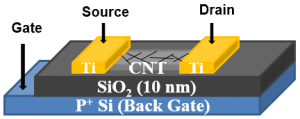 |
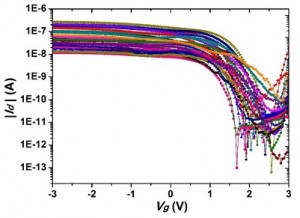 |
As the size of transistors continues to decrease, the silicon-based field-effect transistors has been unable to comply with the development of Moore’s Law, because of the unavoidable short-channel effect. As a special one-dimensional material, carbon nanotubes have high electron and hole mobilities, which can realize short channel and high mobility electronic devices for ballistic transport, and become a hot material to continue Moore’s law. This project is mainly to prepare high performance and high mobility carbon nanotubes thin film transistors and apply them to logic circuits, flexible displays and biological detection.
2.2 CNT/IGZO hybrid thin film transistor
 |
At present, metal oxide semiconductor thin film transistors have attracted widespread attention, especially a-IGZO thin film transistors. Metal oxide thin film transistors have a relatively high light transmittance, and have a higher carrier mobility than amorphous silicon thin film transistors. However, its carrier mobility is still relatively low compared to polysilicon thin film transistors, and it still cannot meet future high-performance display applications. In order to improve the carrier mobility of metal oxide thin film transistors, researchers have combined carbon nanotubes and metal oxides to form a hybrid thin film transistor based on the excellent mechanical and electrical properties of carbon nanotubes. But at present, everyone uses the solution manufacturing process, which is not compatible with the current industrial production of a-IGZO thin film transistors. Our current work mainly focuses on the fabrication of CNT/IGZO hybrid thin film transistors by sputtering, and studies the mechanism of carbon nanotubes to enhance the carrier mobility of IGZO thin film transistors.
2.3 Fabrication of high speed field effect nanotubes on flexible substrates
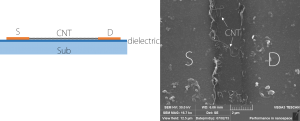 |
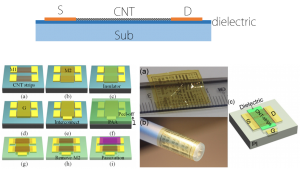 |
Directional-grown semiconducting single-walled carbon nanotubes are used as active regions, and titanium (gold, palladium) and other highly wettable metals are used as source and drain electrodes. According to the electrical characteristics of the carbon nanotubes in contact with the metal, the preparation process of subsequent devices is improved, and the resistance of the metal-carbon nanotube heterojunction is optimized to improve the mobility of the device. The oriented carbon tube was transferred to the flexible substrate PEN using the gold transfer process, and subsequent device preparation (source-drain electrode, gate dielectric, gate electrode) was performed on the PEN to achieve CNT-based FET on the flexible substrate.
2.4 Triboelectric nanogenrator
 |
The triboelectric generator is a new type of micro generator. It can convert the extremely small mechanical energy into electrical energy by the charge pump effect of the friction point potential. Its manufacturing process is simple, low cost, but also has excellent durability and processability, which can be easily integrated into the design of other products. The advantages of CNTs, such as high aspect ratio, high growth density and good flexibility, can enhance the power generation efficiency or broaden its application. Our current work focuses on the vertical transfer of carbon nanotubes and its application in triboelectric nanogenerators.
2.5 Flexible TFT
 |
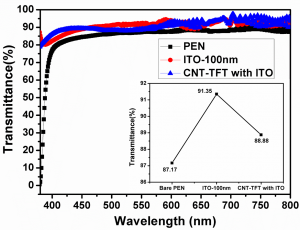 |
Fully transparent and high performance flexible carbon nanotube thin film transistors have broad potential applications in flexible displays. In order to prepare flexible devices with high transparency, we have used the flexible material PEN as the substrate, mature transparent electrode ITO material as the drain, source, and gate electrodes of the device, and a uniform carbon nanotube network as the channel material to achieved a flexible carbon nanotube thin film transistor with 91.1% transparency and excellent electrical properties.
2.6 Cell detection based on TFT
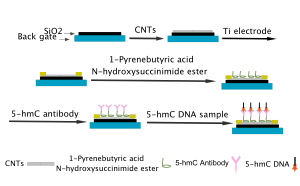 |
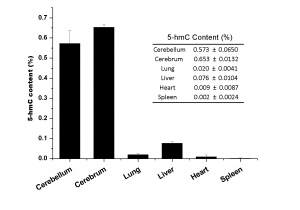 |
As an ideal one-dimensional hollow material, carbon nanotubes have a large specific surface area. The one-dimensional material contains only carbon atoms, and each carbon atom is distributed on the surface of the material, and the size of the carbon atoms matches the size of DNA and the like commonly used in biological detection. Therefore, the application of carbon nanotubes in biological detection has attracted wide interest and attention.We have successfully used CNT thin film transistors with CNTs as channel materials to realize simple, sensitive and rapid detection of 5-hmc DNA. We have also verified and detected the concentration of 5-hmc in different tissues of experimental mice, and obtained a stable concentration change curve. Among them, 5-hmc DNA is the fifth base, which plays an important role in human genetics.